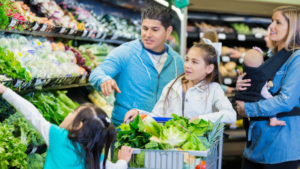Disclosure: Portions of this post were provided by New Hope Network and are from Melaina Juntti’s article, “10 Ways to Say No to Plastic.” I am a member of the New Hope Influencer Co-op, a network of health and wellness bloggers committed to spreading more health to more people. New Hope is NOT related to #PlasticFreeJuly, which is based in Australia.
Unless you’ve been living under a rock, you’ve probably seen a lot of information about plastic recently. Whether it is the Great Pacific Garbage Patch, or the fact that China is no longer accepting plastic from the United States for recycling, we are generating more plastic waste than ever.
Humans have generated 8.3 billion metric tons of plastic since 1950, when plastic first came into common usage, according to a 2017 University of Georgia study. What’s more, almost 80 percent of that plastic is still sitting in landfills or junking up the environment. Plastic—even the “biodegradable” kind—is a permanent substance and in the United States we are using it to solve problems that last for just a minute. (Most biodegradable plastics just break down into smaller and smaller pieces, which might become fish food.) It clogs waterways, chokes out wildlife, and emits an unfriendly mix of chemicals (when it burns or breaks down) that leech into water and soil.
Join me for #PlasticFreeJuly
I just learned about the Plastic Free July Challenge, and I’m game. Are you? According to the Challenge website, the top four sources of plastic waste in takeaway/to-go items are bags, straws, bottles, and coffee cups (either the foam-like self-insulating cups, or the lids on paper cups).
Ideally plastic is like junk food: just don’t bring it home, and you can’t use it. In reality? I get it. There are some applications for which there isn’t a good non-plastic option available to you. (I can think of some medical items that I would rather not re-use, for example!) If you absolutely have to get a plastic thing, choose the least plastic you can, and choose the option that is reusable and try to re-use it as long as you can. Large yogurt containers, for example, can be re-used for storing leftovers (or broken crayon bits, or legos, or…).

Tip #1: Skip Even More Plastic Bags
Choose to Reuse–at ALL The Stores. If you’re a green shopper you probably already bring your own your own re-usable shopping bags to the grocery store. (Do you take them to Target, too?) If you’re choosing paper, remember that you have to re-use them multiple times to reduce the environmenal impact of making them (otherwise the single-use plastic is actually more Earth-friendly, no kidding). I keep mine in the car so they are there when I go shopping, and keep a Chico Bag (or two–they’re small) in my backpack. Next up, do you really need to toss those individual green peppers into a disposable plastic bag? You’re going to wash them before you eat them, so letting them go free-range in your cart shouldn’t be a big deal. Other alternatives: get reusable mesh produce bags, or toss produce right into your cloth shopping bags while you finish shopping. And hey, you don’t need that giant plastic tote from the running store either. Your shoes come in boxes, and you can choose a reusable bag instead–if you work out, you probably have a few dozen.
Avoid the Plastic Wrap Trap. You can save time (and money!) by using a reusable beeswax paper wrap such as Bees Wrap. Many beeswax wrappers will stick to themselves to seal. Just be careful when you wash them: make sure the water is not so hot that the wax melts, and use the softer side of the sponge. When you’re done, many of these wraps are compostable or at least repurpose-able (no more wax = fabric for craft projects). Not ready to commit to beeswax wrap? Try aluminum foil. If you don’t crush it you can wash it and re-use it multiple times. When it has reached the end of its useful life, give it a thorough bath, dry it off, and toss it into in the recycling bin.
Skip the plastic baggies too. At home, choose re-usable storage containers. While those made by baggie companies are reusable, invest in something sturdier that will last longer. IKEA has plastic containers with rubber-sealed lids for $1 each piece, and the ones I’ve had for years are in great shape. You can also choose glass (glass lids are easy at home but tricky in lunches), though I admit it’s less than ideal for families with young children who mess around in the fridge. For lunchboxes, you can wrap sandwiches in waxed paper (which is also compostable, though not accepted by all municipal compost facilities). I’m using silicone “bags” that are resealable and reusable by Stasher. So far, they are holding up very well to multiple uses, reuses, and washes. As a bonus, they are dishwasher safe. Perfect for my pre-race and post-race snacks. They come in multiple colors, include fun limited edition shades.
At the races, skip the plastic bags! You’ve got multiple ways to skip plastic bags here. (1) Unless a race is FORCING you to use a plastic bag as your checked bag, DON’T TAKE ONE! If you run a bunch of races in the same series that insists on using plastic bags (such as Revel or Rock ‘n’ Roll) REUSE your bag. It’s the same identical bag, you don’t need another one. (2) Don’t use a plastic garbage bag as a warm-up in the corrals. Instead, either use clothing you’re willing to toss, or buy something very cheap at the thrift store (bathrobe, anyone?). Clothing tossed at start lines often goes to charity, and some races put it directly on the backs of local people experiencing homelessness (after a good washing, of course). (3) If you carry supplies in a plastic bag–which isn’t a terrible idea, since rain and smart phones don’t go together–choose a freezer bag, and then reuse it. Freezer bags are slightly thicker than regular zip-top bags, which means you can reuse it dozens of times before you will need to replace it. If you’re not going to use your phone to take pictures, a Stasher bag might work well too.
Skip the Plastic Bags at the Gym! Lots of gyms have a roll of plastic bags in the locker room to bag up your wet swimsuit or sweaty gym clothes. As nice as it is to keep those sweaty, wet things from getting loose in your gym bag, a plastic bag is not the best way. Instead, try using your swim or shower towel to wrap those things. I lay the towel on the bench, layer on the wet stuff, fold the towel in half, and then roll it up like sushi.

Tip #2: Choose Wines That Use Real Corks
Celebrate Sustainably! Trust me, I enjoy a good post-race bubbly or glass of shower wine. I’m definitely NOT begrudging you yours! About 15 years ago, buzz began circulating that cork, the classic wine preserver, wasn’t so sustainable. There was concern that cork tree forests were being depleted, so perhaps plastic wine stoppers would be better. Well, the truth is cork production is pretty darned sustainable. The bark can be stripped and used to make wine closures without cutting the trees down, and this process actually makes the trees better able to offset carbon dioxide. Also, Mediterranean cork forests host some of the greatest plant biodiversity on the planet, according to the World Wildlife Fund. So next time you’re selecting wine, opt for bottles with real-cork corks, not plastic stoppers. As a bonus, many wineries will accept corks for recycling, or you can get a cork box through TerraCycle.
Check Your Inner Wine Snob. As an intermediate option, don’t snub your nose at screw-top wine. While screw-tops used to be endlessly mocked as they were only used on cheap, poor quality wines, now even big and fancy wineries are looking at screw-tops. They make it easier to re-seal your wine bottle, but also tend to protect your wine better than corks. And hey, there’s always that old college staple. (No, not Boone’s Farm!) Boxed wine, while lined with a plastic bag, keeps much longer than bottled wine. If you only indulge every now and again, boxed wine might be your best bet…and the more people nudging the wine makers to recycle their packaging, the more likely it is that it will happen.
Stay Tuned for More Tips to Just Say No to Plastic!
In the meanwhile, what’s your top “just say no to plastic” tip? Do you have a tip that is especially applicable to runners?